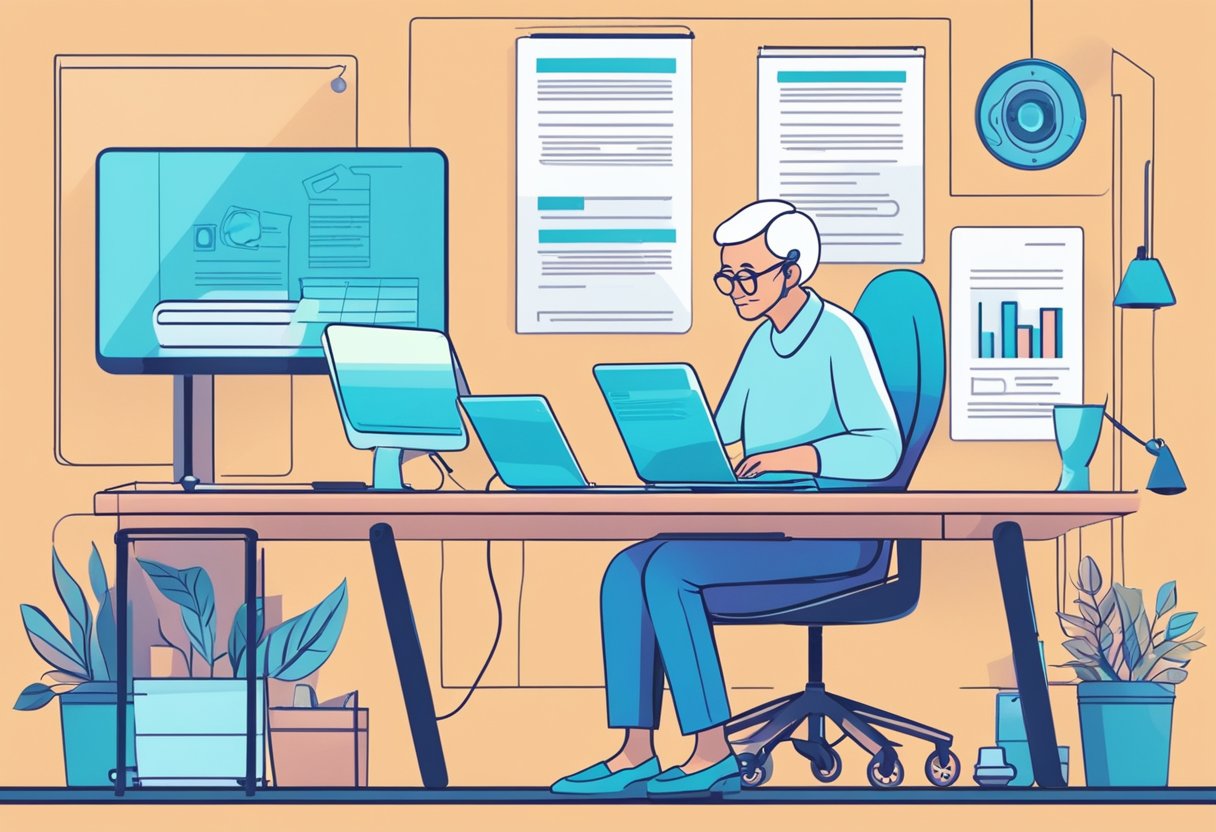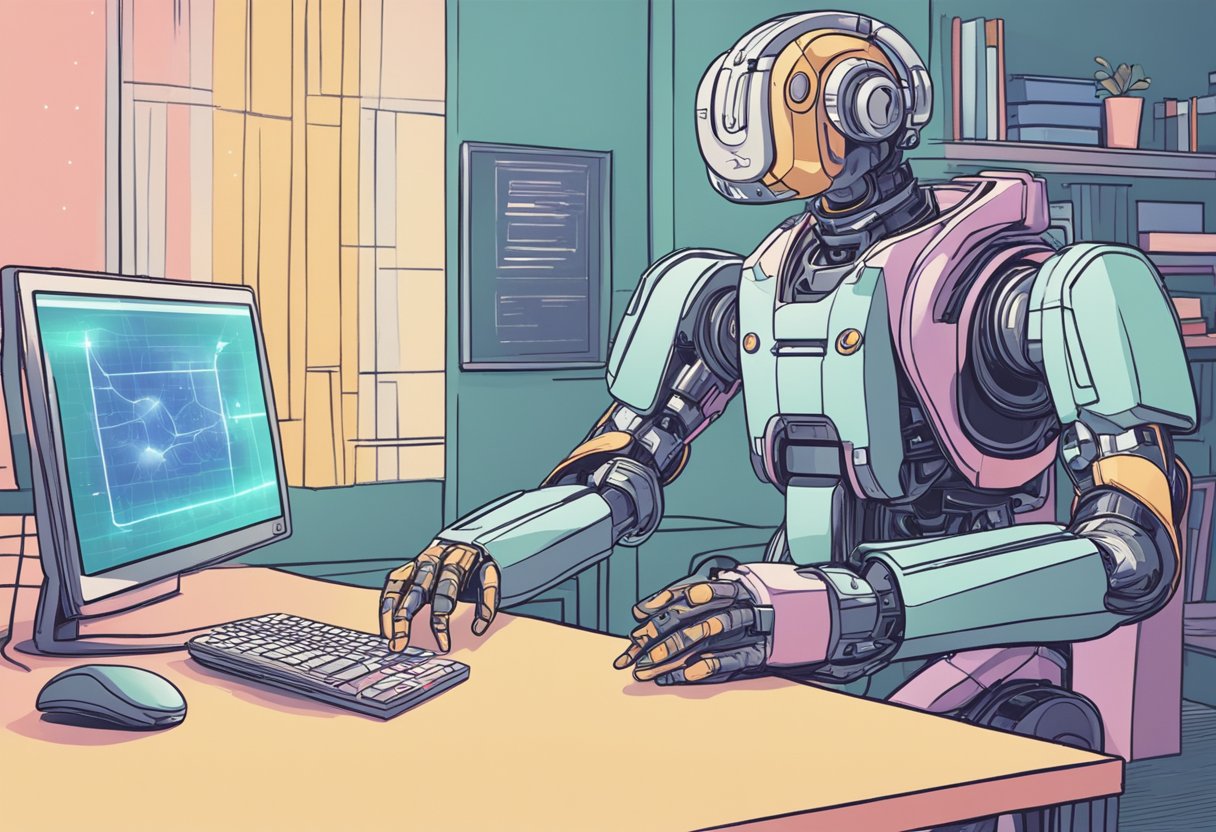AI has the potential to drastically change how seniors live and interact with the world around them. From virtual assistants and chatbots to sensing technology in assisted living facilities, AI is paving the way for improved well-being and a more connected senior experience. However, it’s crucial for older adults to understand not only the advantages AI brings, but also potential limitations and precautions to consider, such as privacy concerns and inherent biases.
Key Takeaways
- AI can improve healthcare and personal well-being for seniors, making their lives safer and more comfortable.
- Understanding the benefits, limitations, and precautions of AI is essential for older adults adopting these technologies.
- Addressing privacy concerns, inherent biases, and digital literacy will help seniors successfully embrace AI’s potential in their daily lives.
Artificial Intelligence and Its Broad Impact
The world of artificial intelligence (AI) is rapidly evolving and holds immense potential for transforming various aspects of your life. AI incorporates a range of technologies, such as machine learning, robotics, and advanced algorithms. As you adapt to this new technological landscape, it’s crucial to understand the broad impact AI can have, especially for seniors.
AI technologies are designed with the goal of making machines capable of learning from data, adapting their behavior based on this insight, and performing tasks that would traditionally require human intelligence. These tasks may include voice recognition, object recognition, and problem-solving.
In the context of senior living, AI can offer numerous benefits. Assistive and autonomous robots can help you perform day-to-day activities, thereby enhancing your quality of life. Similarly, self-driving cars provide safer transportation options that cater to your mobility needs as you age. AI-powered health apps and wearables not only monitor your health but also offer personalized advice based on real-time data, sensors, and algorithms.
Another aspect of AI that directly impacts seniors is the development of smart homes and voice-activated devices. These immensely helpful technologies can be customized to your unique requirements and preferences, ensuring that you maintain your independence and comfort, regardless of age.
The digital infrastructure that powers AI is built by data scientists and engineers who continuously work on refining AI algorithms and expanding the capabilities of this technology. As new technology development progresses, your ability to access and utilize AI tools will only increase. It is essential that you stay informed about these advancements so that you can leverage them to improve your life and maintain a sense of independence.
While AI holds numerous benefits for seniors, it is essential that you remain aware of potential drawbacks to maintaining a balanced perspective on this technology. For example, privacy concerns surrounding the collection and storage of personal data remain a significant issue in the AI landscape. Additionally, the possibility of AI reinforcing existing biases in society must be acknowledged and addressed.
By understanding the broad impact of artificial intelligence and staying informed about its developments, you can confidently navigate the ongoing technological revolution and harness AI to enhance various aspects of your life.
AI in Healthcare for Seniors
As a senior or a caregiver for an elderly person, it’s essential to be aware of the various applications of artificial intelligence (AI) in the healthcare domain. By leveraging AI-based technologies, you can benefit from improvements in safety, efficiency, and personalization of care management1.
For example, AI can help in predicting health risks by analyzing patient data and identifying patterns that may lead to specific health problems. This proactive approach enables healthcare providers to intervene early and tailor treatments to your unique health concerns.
In terms of medicine, AI plays a significant role in drug development and personalized medicine. It helps in speeding up the research process and ensuring that medications are tailored to your specific needs and genetic predispositions, providing a higher level of care.
AI also aims to lighten the load for caregivers by offering:
- Monitoring systems: AI-powered sensors and wearables can keep track of your vital signs, daily activities, and any changes in your behavior or routines. This information is useful for preventive care and early interventions.
- Virtual assistants: These digital companions can assist you with reminders, entertainment, and social interaction, contributing to your overall well-being.
However, it’s crucial to consider the potential health risks and ethical concerns associated with AI in elder care. As AI technologies become more prevalent, you should be aware of:
- Privacy concerns: Sharing your personal health data with AI systems raises questions about data security and potential misuse of information.
- Overreliance on AI: Excessive dependence on technology can lead to loss of human touch in caregiving and a potential for decreased interpersonal interaction.
By understanding the benefits and potential risks of AI in healthcare, you can make well-informed decisions on how to integrate this technology into your care plan, ensuring a higher level of safety, quality, and personalized care in your senior years.
AI’s Role in Enhancing Older Adult’s Well-Being
As you age, maintaining your well-being becomes increasingly important. Artificial intelligence (AI) is a growing field with the potential to improve the health and well-being of older adults in various ways. Below, we’ll explore how AI can assist with challenges you might face as you age, such as social isolation, depression, and cognitive decline.
Managing Social Isolation: Social isolation can have significant negative effects on your mental health. AI-powered assistive technologies are being developed to help older adults stay connected, providing companionship and reducing the risk of depression. AI can facilitate communication, simplifying video calls and helping with language translation so you can effortlessly connect with friends or family members.
Physical Health Monitoring: For seniors, preventing falls and maintaining independence is crucial. AI can assist by monitoring your gait and detecting changes in your movement patterns, alerting caregivers if a potential issue arises. Continuous tracking can help foresee and prevent falls, allowing older adults to maintain their independence longer.
Support for Cognitive Decline: AI can be a valuable tool in the management of cognitive decline, including dementia. Innovative AI applications can help older adults with memory and cognitive challenges through:
- Personalized reminiscence therapy
- Assistance with daily tasks and routines
- Monitoring changes in behavior or patterns of activity
AI programs can learn from your behavior to provide customized care, potentially enhancing your long-term cognitive health.
Promoting Longevity and Independence: Lastly, AI can contribute to older people’s longevity by focusing on proactive health management. By monitoring various aspects of your life, like diet, exercise, and medication adherence, AI can help you make healthier choices and maintain a high quality of life.
In summary, AI has the potential to significantly improve the well-being of older adults by addressing social isolation, monitoring physical health, assisting with cognitive challenges, and promoting longevity and independence. As AI continues to advance, you can expect even more effective solutions to support your well-being in the future.
AI in Assisted Living and Safety Measures
The implementation of AI in assisted living has the potential to greatly improve the quality of life and safety for seniors. By leveraging AI technology, you can benefit from its applications with enhanced safety measures, preventive action and the use of wearable devices.
One key area where AI is transforming assisted living is the use of sophisticated sensors integrated into senior living environments. These sensors detect health risks in real-time, enabling caregivers to provide timely and personalized interventions. The data collected by these sensors can also be analyzed to predict and prevent potential accidents and health issues.
In addition to sensors, wearables are becoming increasingly popular tools in senior care. These devices can monitor vital signs, activities, and even provide location tracking. As a result, care providers can be alerted immediately when an issue arises, allowing them to take necessary action to ensure your safety. Wearables can also be linked to AI-powered platforms, providing valuable insights to help optimize care and better understand your needs.
One of the major concerns with the adoption of AI in assisted living is the security and consent of the data collected. It is crucial that these technologies respect your privacy and only collect and process data with your explicit consent. Regulations like the GDPR (General Data Protection Regulation) play an instrumental role in ensuring that the use of AI in assisted living is done responsibly without breaching personal privacy.
Embracing AI technology in assisted living offers numerous benefits, such as real-time monitoring, proactive care, and increased safety and security. By carefully considering the various implications and following relevant guidelines, AI can serve as a valuable tool to enhance the quality of life and safety in assisted living settings.
Privacy Concerns and Regulatory Aspects of AI

As a senior interested in Artificial Intelligence (AI), it’s essential to be aware of the privacy concerns and regulatory aspects surrounding this technology. AI systems are developed using data that reflect society’s implicit and explicit biases, leading to significant concerns about how predictive models amplify inequity, privilege, and power in society (source).
When it comes to privacy, one major concern is the control of your personal information. By using AI-driven applications or platforms, you may unintentionally share sensitive data with others. In response to these concerns, various governance frameworks and legal frameworks have been developed to protect your rights and control over your data.
To help ensure data privacy, you can take advantage of the following guidelines, technical measures, and policies:
- Accountability: Ensuring that AI developers and data controllers are accountable for adhering to data protection principles is central to data privacy laws and regulations (source).
- Algorithmic Fairness: By supporting policies that advocate for algorithmic fairness, you can contribute to creating a baseline for AI regulation, as seen in the American Data Privacy and Protection Act (ADPPA) (source).
- Transparency: Examining the AI systems you use, encouraging increased transparency, and understanding how your data is processed can be key steps in maintaining your privacy (source).
To ensure that your privacy remains safe in an AI-driven world, stay informed and proactive about the regulatory aspects and governance frameworks for AI, and be mindful of your data sharing habits. This will help you contribute to an environment where AI technology is both beneficial and respectful of your privacy.
Understanding and Overcoming the Inherent Biases of AI

Artificial Intelligence (AI) has increasingly become a part of our lives, providing various benefits across industries including healthcare, finance, and transportation. However, AI systems have been known to inadvertently propagate biases such as ageism and discrimination due to the societal assumptions and stereotypes embedded in their training data. In this section, we will discuss ways to understand and overcome these inherent biases.
When developing AI systems, it is crucial to recognize the potential for biases in the data being used. Bias refers to any systematic error that skews the AI models’ output or predictions. Biases can lead to harmful consequences, such as unfair treatment and discrimination towards particular demographic groups like seniors. One of the critical aspects to consider is ageism, which manifests as prejudice or discrimination based on a person’s age, particularly towards older individuals. In the context of AI, ageism has been identified as a major concern for older adults since AI’s biased decisions could negatively impact their health and well-being.
To address these biases, you can start by following these steps:
- Analyze the data: Examine your training data and algorithms for any signs of existing biases, assumptions, or stereotypes. This analysis can help you identify potential issues at an early stage and make necessary adjustments.
- Obtain diverse and representative data: Collect data that accurately reflects the diversity of the population you are trying to serve. By incorporating more diverse data sources, your AI models will be better equipped to make unbiased, accurate predictions.
- Implement fairness and transparency: Use AI techniques and methodologies specifically designed to ensure fairness and minimize discrimination. Explainable AI (XAI) methods, for example, can increase the transparency of the decision-making process, allowing you to understand and address bias-related issues.
- Monitor and update: Continuously evaluate and benchmark your AI models against fairness criteria and update them accordingly as your training data evolves.
- Ethics-aware development: Foster a culture that prioritizes ethical AI development, ensuring that stakeholders, including developers and decision-makers, are aware of the potential biases and are committed to minimizing discrimination.
Being aware of the inherent biases in AI and taking the necessary steps to minimize them will help you create more inclusive, fair, and accurate AI systems. By addressing ageism and other forms of discrimination, you are not only ensuring that the benefits of AI are accessible to seniors but also contributing to building a more equitable society for everyone.
Design and Development Considerations of AI for Seniors

When it comes to designing and developing AI technologies for seniors, there are specific considerations to keep in mind. By adhering to these guidelines, you can create AI solutions that are beneficial, accessible, and enjoyable for older adults.
Firstly, focus on participatory design and work directly with seniors while creating AI technologies. When you involve older adults in the development process, you can better understand their needs, preferences, and expectations. This participatory design approach ensures that the final product is tailored to their requirements.
Secondly, strive for user-centered design. You should prioritize making AI technology intuitive and easy to use for seniors. For instance, providing clear instructions, simplified interfaces, and obvious visual cues will make it natural for them to interact with the AI solution.
Thirdly, ensure inclusive design. To create AI technologies that are accessible to all seniors, including those with disabilities, consider the diverse range of physical, cognitive, and sensory abilities within this age group. Design the technology in such a manner to accommodate these differences. For example, include alternative text for images, larger font sizes, and distinct color contrasts.
Fourthly, implement co-design. Collaborate with interdisciplinary teams, including data scientists, UX designers, and gerontologists, to ensure the AI technology is responsive to the unique needs and abilities of the senior population. These age-diverse data science teams can create an environment that fosters creativity, innovation, and understanding of diverse perspectives.
To summarize, when developing AI technologies for seniors, focus on the following:
- Participatory Design: Involve older adults in the development process.
- User-Centered Design: Prioritize intuitive and easy-to-use interfaces.
- Inclusive Design: Accommodate the diverse range of abilities among seniors.
- Co-Design: Collaborate with interdisciplinary teams, including gerontologists.
By adhering to these design principles, you can create AI solutions tailored to the unique needs and abilities of the older population, including the baby boomer generation. This approach ensures that seniors can reap the benefits of AI technology while feeling confident, supported, and engaged in its use.
Digital Literacy and AI Adoption Among Seniors
As a senior, your digital literacy plays a crucial role in how well you can understand and engage with artificial intelligence (AI) technologies. With a rapidly evolving digital landscape, it is vital for older adults to stay updated and build necessary digital skills. This not only makes it easier to navigate new technologies but also helps you take advantage of benefits they offer.
One way to improve your digital literacy is through education activities. By participating in courses, workshops, or online tutorials, you can gain essential knowledge and skills to understand how AI works and how it can be integrated into your daily life. Notably, a study has shed light on AI literacy among older adults, providing valuable insights and recommendations to enhance AI competencies through educational and awareness initiatives.
Intergenerational interventions can be another effective approach to improve seniors’ digital literacy. Learning from younger generations who are more tech-savvy could be mutually beneficial, fostering greater understanding between different generations while promoting a smoother transition into the digital age for older adults.
To ensure success in engaging with AI technologies, it is important to address the following key elements for seniors:
- Digital access: Obtaining necessary hardware, software, and stable internet connections to facilitate engagement with AI and other digital technologies.
- Education and training: Enhancing digital skills and knowledge through courses, workshops, or self-paced learning resources.
- Support and guidance: Receiving assistance from friends, family, or community organizations that can provide tailored help in understanding and using AI technologies.
By considering these factors and actively working on your digital literacy, you will be better equipped to engage with AI technologies and understand their impact on your life. Progressing beyond basic digital skills, a solid grasp of AI can ultimately enable you to make well-informed decisions and harness the potential of AI to improve your overall quality of life.
AI, Aging Society, and the Way Forward
As the global aging population continues to grow, it becomes increasingly important for you and the rest of society to understand how artificial intelligence (AI) can empower and support seniors. According to the World Health Organization (WHO), AI technologies have the potential to improve older people’s health and well-being, but only if ageism is eliminated from their design, implementation, and use.
To tackle this challenge, various organizations like OHCHR, UNDESA, and UNFPA have joined hands in promoting age-inclusive policies. A crucial step in this direction is the creation of age-diverse data science teams. By including seniors in the development and design of AI technologies, you can gain unique insights from their experiences, ensuring that AI applications are tailored to seniors’ needs.
Furthermore, it is essential to adopt age-inclusive data collection methods. As a stakeholder in AI development or deployment, you should pay close attention to the demographics being represented in the data. This will help in avoiding biased AI systems that could inadvertently discriminate against the elderly.
In addition to these efforts, organizations like the WHO have released policy briefs advising on how to enhance AI technologies for seniors. Some key aspects outlined for your consideration are:
- Encourage intergenerational contact to overcome age-based stereotypes and foster better understanding between different age groups.
- Promote accessibility and usability of AI systems through user-friendly interfaces, clear instructions, and comprehensive support.
- Ensure that AI solutions address the diverse needs of seniors, taking into account factors such as physical or cognitive impairments and distinct living situations.
By embracing these guidelines, you can contribute to creating a society where AI plays a vital role in supporting and empowering seniors. Engaging in contests, data, and research initiatives will encourage AI developers to focus their efforts on ethical and age-inclusive solutions, ultimately leading to a better future for the aging population.
Remember, your active involvement and commitment to understanding the dynamic relationship between seniors and AI is crucial in shaping a more inclusive, equitable, and resilient society for all.
Frequently Asked Questions
How can AI improve home healthcare for seniors?
AI has the potential to revolutionize home healthcare for seniors. Devices like ElliQ by Intuition Robotics can offer social companionship and reminders for medication or exercise routines. Additionally, AI-powered technologies such as ambient monitoring sensors and voice-activated assistants can help seniors maintain their independence by supporting daily activities and tasks.
What challenges do seniors face when learning about new technology?
Seniors may face a “physical-digital divide” when it comes to learning about and using new technology. This divide occurs when older adults feel ostracized due to their inability to engage with new technologies being used around them. Challenges may include lack of digital literacy, reluctance to adapt to new technology, or physical limitations affecting their ability to use devices.
In what ways can AI assist in elderly care and monitoring?
AI can assist in elderly care by predicting health risks and detecting health anomalies early on. For instance, AI technology can enable drug discovery and create personalized care plans for older adults. Additionally, AI-powered monitoring devices can track vital signs, daily activities, and even detect falls, allowing for quicker response times and intervention in case of emergencies.
What are the potential drawbacks of relying on AI for senior care?
While AI offers many benefits, there are potential drawbacks to consider. Overreliance on AI technologies may lead to decreased social interaction and isolation for seniors. Additionally, AI technologies may introduce ageism due to biased data or algorithms, which might cause unfair treatment towards the aging population. There is also a risk of data privacy and security breaches, which could negatively impact seniors’ trust in these technologies.
How can AI be integrated into current technologies to aid seniors?
AI can be integrated into existing technologies such as smartphones, smartwatches, and voice-activated assistants to aid seniors in daily tasks. For example, AI-powered personal assistants like Amazon’s Alexa, Google Assistant, or Apple’s Siri can answer questions, set reminders, and control smart home devices. These integrations can also include wearables and IoT devices to monitor seniors’ health, track their location, and alert caregivers or family members in case of emergency situations.
What are some emerging AI innovations specifically designed for elder care?
Emerging AI innovations for elder care include Intuition Robotics’ ElliQ – a talking device which acts as a social companion for seniors and assists with staying connected to family members. Technologies like Ambient/Active Assisted Living (AAL) robots and other AI systems can support independent living by providing assistance with daily tasks, medication management, and monitoring vital signs.






